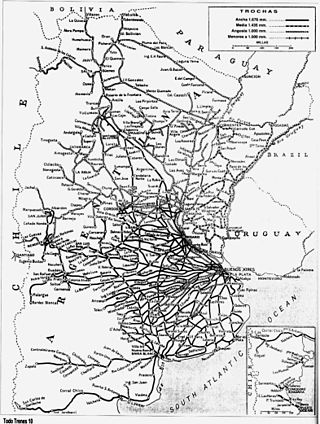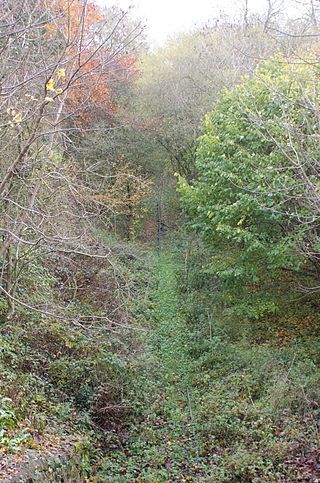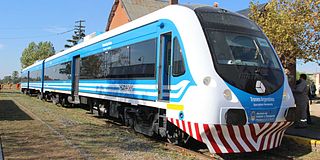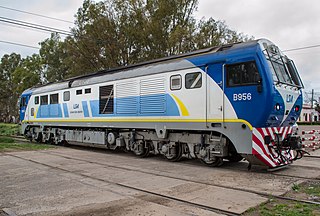
The railway system in Great Britain is the oldest railway system in the world. The first locomotive-hauled public railway opened in 1825, which was followed by an era of rapid expansion. Most of the track is managed by Network Rail, which in 2017 had a network of 9,824 miles (15,811 km) of standard-gauge lines, of which 3,339 miles (5,374 km) were electrified. These lines range from single to quadruple track or more. In addition, some cities have separate metro, light rail and tram systems. There are also many private railways, which are primarily short lines for tourists. The main rail network is connected with that of continental Europe by the Channel Tunnel and High Speed 1, which fully opened in 1994 and 2007 respectively.

A heritage railway or heritage railroad is a railway operated as living history to re-create or preserve railway scenes of the past. Heritage railways are often old railway lines preserved in a state depicting a period in the history of rail transport.

The Nene Valley Railway (NVR) is a preserved railway in Cambridgeshire, England, running between Peterborough Nene Valley and Yarwell Junction. The line is 7+1⁄2 miles (12.1 km) in length. There are stations at each terminus, and three stops en route: Orton Mere, Ferry Meadows and Wansford.

Woodham Brothers Ltd is a trading business, based mainly around activities and premises located within Barry Docks, in Barry, South Wales. It is noted globally for its 1960s activity as a scrapyard, where 297 withdrawn British Railways steam locomotives were sent, from which 213 were rescued for the developing railway preservation movement.

The Barry Tourist Railway is a railway developed to attract visitors to Barry in the Vale of Glamorgan, South Wales. It is a key element of the Barry Rail Centre which also includes engineering and training facilities.

Uyuni is a city in the southwest of Bolivia.
Vic Berry's Scrapyard was a large railway scrapyard situated in the former Great Central Railway Braunstone Gate goods yard in Leicester.

CRRC Qingdao Sifang Co., Ltd. is a Chinese rolling stock manufacturer based in Qingdao, Shandong province. Founded in 1900 during the German occupation, Qingdao Sifang is one of the oldest rolling stock manufacturers in China.
CRRC Tangshan Co., Ltd., is a manufacturer of rolling stock located in Tangshan, Hebei province, People's Republic of China. While Datong built mainline steam locomotives until 1988, Tangshan built steam for industrial use until 1999, becoming the last works in the world to build steam for non-tourist use.

Steam Incorporated, often abbreviated to Steam Inc., is a railway heritage and preservation society based at the Paekākāriki railway station, Paekākāriki at the southern end of the Kāpiti Coast, approximately 50 minutes north of Wellington on the west coast of New Zealand's North Island. Unlike some societies who operate on preserved sections of closed branch lines, Steam Incorporated owns a depot beside one of the country's most important railway lines, the North Island Main Trunk railway, and restores heritage locomotives and rolling stock for use on excursions on the regular national rail network.

The Belgrano Sur line is an Argentine 1,000 mmmetre gauge commuter rail service in the Greater Buenos Aires area, currently operated by state-owned enterprise Trenes Argentinos. The Belgrano Sur runs over tracks and through stations built by the Franco–Belgian-owned Compañía General de Buenos Aires and British Midland companies at the beginning of the 20th century.

The Argentine railway network consisted of a 47,000 km (29,204 mi) network at the end of the Second World War and was, in its time, one of the most extensive and prosperous in the world. However, with the increase in highway construction, there followed a sharp decline in railway profitability, leading to the break-up in 1993 of Ferrocarriles Argentinos (FA), the state railroad corporation. During the period following privatisation, private and provincial railway companies were created and resurrected some of the major passenger routes that FA once operated.
China CNR Corporation Limited (CNR) was a primary manufacturer of locomotives and rolling stock for the Chinese market. The company has also exported to over 80 countries and regions, including Argentina, Australia, Brazil, France, Hong Kong, New Zealand. Saudi Arabia, Taiwan and Turkey.

Valley Railroad 3025 is a China Railways SY class steam locomotive that was built in 1989 by the Tangshan Locomotive and Rolling Stock Works for the Knox and Kane Railroad, where it spent its life until that railroad's demise. It was purchased by the Valley Railroad Company in 2008 and has since been rebuilt as a masquerade of a New Haven J-1 "Mikado" locomotive and re-numbered 3025.

The Bromyard and Linton Light Railway is a 1-mile (1.6 km) single track, 2 ft narrow gauge railway line that runs between Bromyard and the Linton Industrial Estate, just off the A44. The track is laid on the bed of the old BR Worcester, Bromyard and Leominster Railway line. The track runs from an old depot, close to the site of the old Bromyard station, and ends under a bridge near a hospital turned flat block. The bridge was constructed in 1877 and carries a lane. There are disused engines in sheds at the main depot and Linton depot. The present track was used for the disused sandstone quarry.

China Railway SY is a 2-8-2 Mikado locomotive operated by the China Railway. It was built mostly by Tangshan Railway Vehicle between 1960 and 1999.

Materfer is an Argentine manufacturer of railway and road vehicles, located in the city of Ferreyra in Córdoba Province. The company was established by Fiat Concord in the late 1950s, being its subsidiary until 1980 when Sevel Argentina took over Fiat vehicles.

The CSR SDD7 is a 2,249 hp diesel-electric locomotive manufactured by CSR Corporation Limited from 2013 onwards for use in Argentina by Trenes Argentinos, a subsidiary of Ferrocarriles Argentinos S.E. On the San Martín Line in Buenos Aires Province, 24 of these locomotives are used, making up the entire rolling stock of the commuter rail line.

A vehicle graveyard, cemetery, or boneyard is a location in which several vehicles, often of the same type, have been abandoned. The vehicles might be awaiting dismantling or recycling, or may just be left to decay. Most sites are intentionally created and many have security to protect them while others are forgotten and lay undiscovered for some time. These sites can be popular destinations for urban explorers.


















